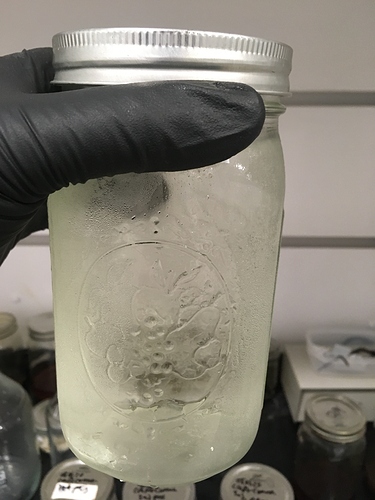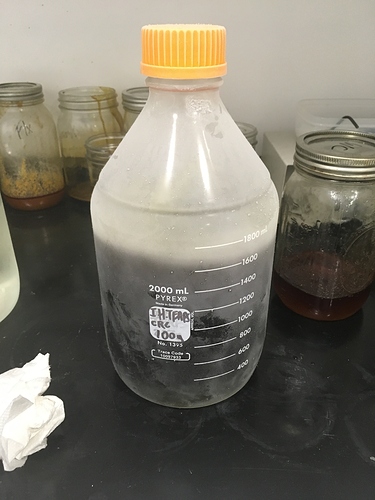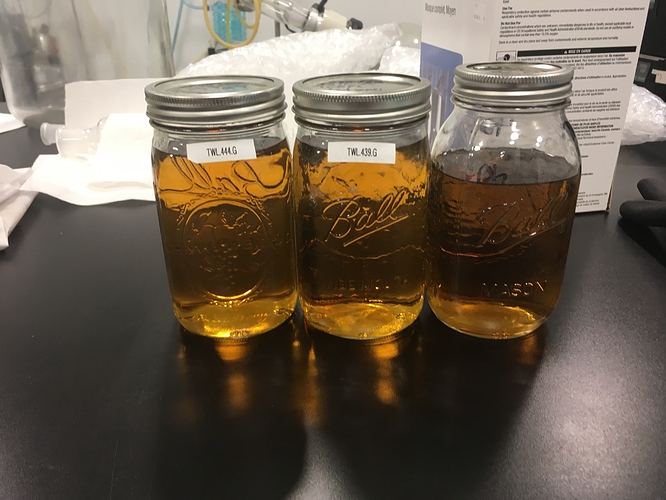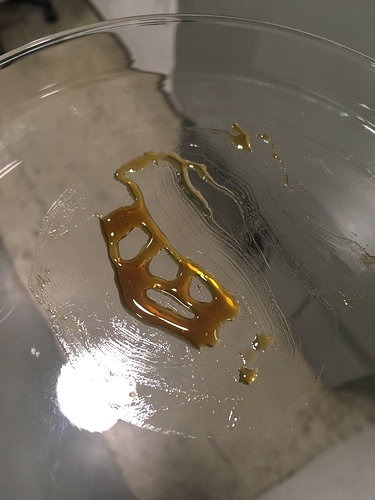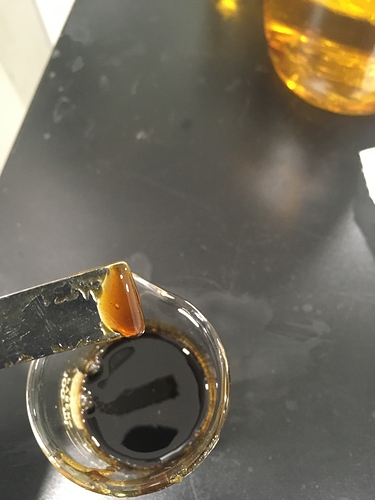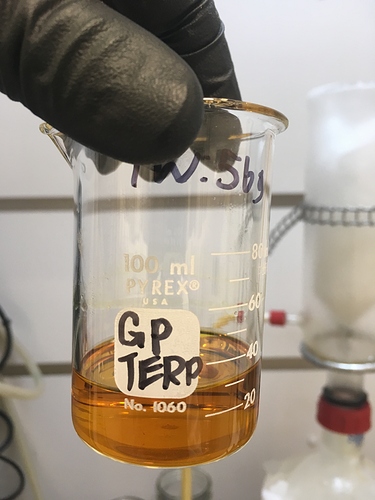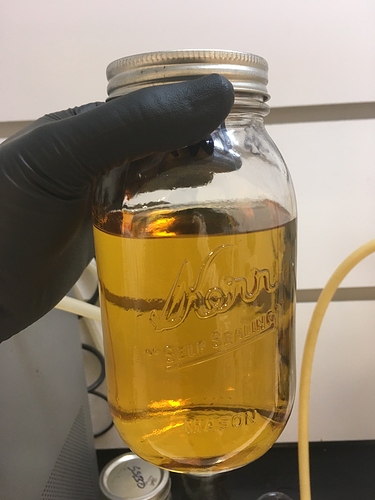What’s up F4200 community!
So I’ve been experimenting with a batch of dark ass terps ive been collecting from thca separations. So there’s a couple of Ether barrels that got dropped off at our lab by some one who left them and never picked them up. Tried calling hazardous waste companies to dispose of it and no one wants to deal with it. So I had to improvise and put them to use. So I decided to try turning the black colored terps to something more appealing to the eye. To do that I prepped a hochstrem(however it’s spelled) filter with some Crc media and diluted 250g of terps into 1750ml of ether. I then filtered through the media’s and have gotten mixed results ranging from reds, yellow, oranges, amber to water clear. Now what trips me out is why I’m getting so many different colors. I don’t know, I guess I want to get input by other like minded individuals on what they think about my process. It’s not something I do normally I’m just R&Ding. Also when I reclaim the ether the terps tumr dark in some colors except for the really bright ones. Any idea why? I’ve never done work like this l, so yeah…
The media bottle is the start material.
Which ether? (I assume diethyl?) Careful open filtering that stuff.
What media, what ratios etc? Are your parameters the same between runs? Is it all the same starting material?
Diethyl, prior to blending with terps I distill the ether with a roto, hooked up to diaphragm pump with a cold trap. Haven’t had issues, I also change pump
Oils often to prevent solvent build up.
All the work I do is under fume hood and I wear a fitted 3m filtered mask.
The media’s ive been playing with but for the most part have been consistent.
I use filtration paper on base followed by celite, T5, silica. I’m limited to the media’s I can use cause well that’s all I have right now
And yeah same start material. Same weights and dilution levels.
So:
Same amount of the same material, dissolved in the same amount of the same solvent, filtered through the same amounts the same media? And you’re getting different colors. That’s unusual. Other variables could be how quickly you filter (residence time), temperature, and how dry the media is. Any of those variables different between runs?
P.S. wasn’t harping about the safety, just figured a reminder couldn’t hurt. Sounds like you’ve got it we’ll in hand.
Well I’ve bern using different media ratios. As for the other elements…all the same. Well just once I divided the 2000ml media bottle into four jars and poured individually and collected them after each pour off in different jars and I got four different colors. That really trip me out. Also one of my filtration came out see through green/grayish and next morning I checked up and it was orange. I was like wtf?? Lol I’ve never experienced such things that’s why I’m looking to see other people’s ideas or thoughts on this. And I’ll share my media ratios later since I have it on my notes. And thanks for the heads up workgroup safely, I think that’s something everyone here should be on top off. I actually just recently completed the OSHA-30 course to educate my self more on Leung a safe and healthy work environment. ![]()
Sorry for the typos
Can you explain “residence time”?
Write the open date on the bottle too, if it gets too old it may become explosive and you will need to call hazmat.
Interesting, on what bottle are you referring too?
Yes so the slower you filter, the longer the compounds dissolved in your solvent have to be adsorbed onto the media. If you suck very fast, there will be less time that the compounds (impurities/pigments) have in contact with the media. Not a huge variable but definitely could be a factor.
This sounds like it would either be related to pH or oxidation. Remember, color changes usually indicate chemical reactions occurring. Checking your pH before and after would probably be worthwhile regardless while playing with the magic dirts.
In this experiment, did you pour them sequentially through the same cake or did you use fresh cakes (media) for each pour? Also, do you wash the media with excess solvent after filtering your media?
One more: did you recover the ether after filtering and compare recovered weights? Could be that your difference in color is reflecting different amounts of material eluting (ie less terps come out in the same amount of solvent will look lighter).
I’ve never really worked with ether other than using it to start engines lol, did not know there was a storage stability issue. Thanks for the heads up
I see what your saying, so slower filtration is better then? And I have been messing with my speeds too somyeah that’s a good point. Also I think your right, I believe the silica has the ability to change ph levels, that’s something I spoke to my boss about. My thoughts were that since the solvent was cold (-40) when I filtered, I think the ph acted differently when the temp changed and reached room temp. That reaction was more desirable in my case cause it went from like i said a green/grey to light orange. To answer that last question, that’s the step I’m in right now. I’m recovering the ether and collecting the terps. Once finished I’m going to see how much loss I’ve got. I feel like some of the terp oils might be getting stuck on media. Oh and yes, I do a pre soak with clean ether and a final wash after it done collecting my desired colors. As for the exepreremt I did dividing the media bottle in jars, yes I poured all through one media mix.
I appreciate your time bro. Interesting to hear other people’s opinions and thoughts.
Peroxides and Ethers
The following is from CRC Handbook of Laboratory Safety, 5th Edition. Furr, A. Keith.
Ethers
Ethers represent a class of materials which can become more dangerous with prolonged storage because they tend to form explosive peroxides with age. Exposure to light and air enhance the formation of the peroxides. A partially empty container increases the amount of air available, and hence the rate at which peroxides will form in the container. It is preferable, therefore, to use small containers which can be completely emptied, rather than take the amounts needed for immediate use from a large container over a period of time, unless the rate of use is sufficiently high so that peroxides will have a minimal time in which to form.
Ethyl ether, isopropyl ether, tetrahydrofuran, and many other ethers tend to absorb and react with oxygen from the air to form unstable peroxides which may detonate with extreme violence when they become concentrated by evaporation or distillation, when combined with other compounds that give a detonatable mixture, or when disturbed by unusual heat, shock, or friction. Peroxides formed in compounds by autoxidation have caused many laboratory accidents, including unexpected explosions of the residue of solvents after distillation, and have caused a number of hazardous disposal operations.
From some uni website on Google
That was very informative. Thanks for sharing that.
A barrel of ether you say? Put the bomb squad on your speed dial ![]()
On a serious note; wtf do you have a barrel of ether for?
I think he said diethyl but things one could also:
- Steal grandma’s oxygen mask and run a pure ether/oxygen mix and party like it’s 1800 with all your friends
- Sell it to a biker gang meth factory
- Sell it to a cartel blow refinery
Yeah so a couple points:
When you start filtering, the nonpolar compounds that don’t adsorb too well are washed through but the more polar compounds take longer to wash through. So you tend to get lighter material with less junk at the beginning than at the end.
The T5 is actually more of an issue for pH than the silica because it is acid activated.
Lastly, keep in mind that adsorption is a chemical process which requires activation energy: it tends to work better at warmer temperatures because of this. By better, I mean you reach equilibrium faster. Going slower can allow you to reach/approach equilibrium as well without the downside of you know, working with hot ether lol. BUT you may not actually want to reach equilibrium because that can include adsorbing a bunch of yield into your media too.
What I would recommend is to:
Evaluate all of the variables;
Fix whichever variables you can easily at convenient values;
Adjust one variable at a time picking the ones that are harder to fix
Tell me about it bro, I honestly don’t like working with it. So some douche bag “consultant” ordered it to our facility claiming he has a proprietary tech that made the best distillate using ether and god knows what. Piece of shit ended up leaving that shit there and never picked it up or used it. And we understand that’s an issue. So we’re trying to use it as a way of disposing it. But yeah man I feel you bro.
